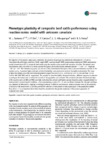Use este identificador para citar ou linkar para este item:
http://www.alice.cnptia.embrapa.br/alice/handle/doc/940020Registro completo de metadados
| Campo DC | Valor | Idioma |
|---|---|---|
| dc.contributor.author | SANTANA JÚNIOR, M. L. | pt_BR |
| dc.contributor.author | ELER, J. P. | pt_BR |
| dc.contributor.author | CARDOSO, F. F. | pt_BR |
| dc.contributor.author | ALBUQUERQUE, L. G. | pt_BR |
| dc.contributor.author | FERRAZ, J. B. S. | pt_BR |
| dc.date.accessioned | 2012-11-20T11:11:11Z | pt_BR |
| dc.date.available | 2012-11-20T11:11:11Z | pt_BR |
| dc.date.created | 2012-11-20 | pt_BR |
| dc.date.issued | 2013 | pt_BR |
| dc.identifier.citation | Animal, Cambridge, v. 7, n. 2, p. 202-210, Feb. 2013. | pt_BR |
| dc.identifier.issn | 1751-732X | pt_BR |
| dc.identifier.uri | http://www.alice.cnptia.embrapa.br/alice/handle/doc/940020 | pt_BR |
| dc.description | The objective of the present study was to determine the presence of genotype by environment interaction (G × E) and to characterize the phenotypic plasticity of birth weight (BW), weaning weight (WW), postweaning weight gain (PWG) and yearling scrotal circumference (SC) in composite beef cattle using the reaction norms model with unknown covariate. The animals were born between 1995 and 2008 on 33 farms located throughout all Brazilian biomes between latitude −7° and −31°, longitude −40° and −63°. The contemporary group was chosen as the environmental descriptor, that is, the environmental covariate of the reaction norms. In general, higher estimates of direct heritability were observed in extreme favorable environments. The mean of direct heritability across the environmental gradient ranged from 0.05 to 0.51, 0.09 to 0.43, 0.01 to 0.43 and from 0.12 to 0.26 for BW, WW, PWG and SC, respectively. The variation in direct heritability observed indicates a different response to selection according to the environment in which the animals of the population are evaluated. The correlation between the level and slope of the reaction norm for BW and PWG was high, indicating that animals with higher average breeding values responded better to improvement in environmental conditions, a fact characterizing a scale of G × E. Low correlation between the intercept and slope was obtained for WW and SC, implying re-ranking of animals in different environments. Genetic variation exists in the sensitivity of animals to the environment, a fact that permits the selection of more plastic or robust genotypes in the population studied. Thus, the G × E is an important factor that should be considered in the genetic evaluation of the present population of composite beef cattle. | pt_BR |
| dc.language.iso | eng | eng |
| dc.rights | openAccess | eng |
| dc.title | Phenotypic plasticity of composite beef cattle performance using reaction norms model with unknown covariate. | pt_BR |
| dc.type | Artigo de periódico | pt_BR |
| dc.date.updated | 2013-06-24T11:11:11Z | pt_BR |
| dc.subject.thesagro | Gado de corte | pt_BR |
| dc.description.notes | Firstview article 27 set. 2012. | pt_BR |
| riaa.ainfo.id | 940020 | pt_BR |
| riaa.ainfo.lastupdate | 2013-06-24 | pt_BR |
| dc.contributor.institution | UNIVERSIDADE FEDERAL DE MATO GROSSO; USP; FERNANDO FLORES CARDOSO, CPPSUL; UNIVERSIDADE ESTADUAL PAULISTA; USP. | pt_BR |
| Aparece nas coleções: | Artigo em periódico indexado (CPPSUL)  | |
Arquivos associados a este item:
| Arquivo | Descrição | Tamanho | Formato | |
|---|---|---|---|---|
| CardosoAnimal.pdf | 323,96 kB | Adobe PDF |  Visualizar/Abrir |









